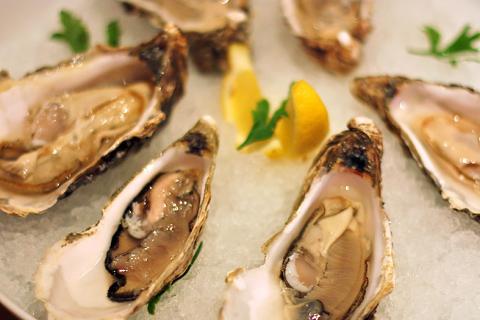Just In Bistro and Wine Bar, which was opened in Taipei two years ago by Singaporean chef Justin Quek (郭文秀), recently launched its new flagship location on the ground floor of Neo 19. The restaurant features an oyster bar and offers a sleeker ambiance to fit in with its surroundings, but fans of the original Just In Bistro near the corner of Civic Boulevard and Dunhua South Road might miss its warmer, more intimate atmosphere and daily tapas specials.
The new space is much larger and features an anteroom with a large, circular bar. An array of premium spirits and liquors are lined up on tall glass shelves, while a small seafood bar in the center displays imported oysters. The dining room is decorated
in white, with pink and green plush upholstery and heavy beaded curtains.

Photo: Catherine Hsu, Taipei Times
Our server informed us that the new location’s goal is to feature more fusion cooking. In addition to the usual French bistro offerings like duck confit with salad and sauteed potatoes (NT$720), baked escargot (NT$480 for a dozen) and steak served with pomme frites (NT$1,320), the menu also has an “Asian inspired” section with offerings like laksa (a Malay stew) with half a Maine lobster (NT$970). The tapas menu at the new location is relatively short compared with that of the original Just In Bistro, which had daily specials, but it still features some of the restaurant’s best sellers like homemade chicken and duck foie gras pate with Armagnac jelly (NT$350) and grilled king oyster mushrooms (NT$120).
Just In Bistro’s selection of imported oysters changes daily; they’re served on a bed of ice with lemon, shallots and red wine vinegar and cocktail sauce. We ordered six French Breton oysters (NT$1,250 or NT$220 each) because our server said they were stronger in flavor than the other selections. We were not disappointed. Each oyster was served with its briny liquor and needed no extra flavorings — a good thing, because Just In Bistro’s selection of sauces, which included ketchup mixed with Tabasco sauce, was lacking.
My main course was the braised lamb shoulder with mousseline potatoes and ratatouille (NT$650), while my companion ordered Angus beef sirloin (NT$1,320), which was described on the menu as having been fed for 300 days with grain and weighing in at 220g. It came with salad and frites. Both meats were tender and delicious, though the sides were forgettable.
My companion paired his meal with a glass of 2006 Casa Lapostolle merlot (NT$280) from Chile, while I ordered a 2010 Torres Vina Esmerelda Moscatel Gewurztraminer from Spain (NT$220 for a glass). The dregs of the merlot were poured into his glass before the woman serving us our wine walked away with a muttered “sorry.” Since she did not return for several minutes, we pondered calling our main waitress over to ask for a new glass, but our wine server finally reappeared with a freshly opened bottle, which she used to fill up the glass of merlot. That was the only hiccup in Just In Bistro and Wine Bar’s otherwise excellent service.

June 23 to June 29 After capturing the walled city of Hsinchu on June 22, 1895, the Japanese hoped to quickly push south and seize control of Taiwan’s entire west coast — but their advance was stalled for more than a month. Not only did local Hakka fighters continue to cause them headaches, resistance forces even attempted to retake the city three times. “We had planned to occupy Anping (Tainan) and Takao (Kaohsiung) as soon as possible, but ever since we took Hsinchu, nearby bandits proclaiming to be ‘righteous people’ (義民) have been destroying train tracks and electrical cables, and gathering in villages

Dr. Y. Tony Yang, Associate Dean of Health Policy and Population Science at George Washington University, argued last week in a piece for the Taipei Times about former president Ma Ying-jeou (馬英九) leading a student delegation to the People’s Republic of China (PRC) that, “The real question is not whether Ma’s visit helps or hurts Taiwan — it is why Taiwan lacks a sophisticated, multi-track approach to one of the most complex geopolitical relationships in the world” (“Ma’s Visit, DPP’s Blind Spot,” June 18, page 8). Yang contends that the Democratic Progressive Party (DPP) has a blind spot: “By treating any

This year will go down in the history books. Taiwan faces enormous turmoil and uncertainty in the coming months. Which political parties are in a good position to handle big changes? All of the main parties are beset with challenges. Taking stock, this column examined the Taiwan People’s Party (TPP) (“Huang Kuo-chang’s choking the life out of the TPP,” May 28, page 12), the Democratic Progressive Party (DPP) (“Challenges amid choppy waters for the DPP,” June 14, page 12) and the Chinese Nationalist Party (KMT) (“KMT struggles to seize opportunities as ‘interesting times’ loom,” June 20, page 11). Times like these can

Swooping low over the banks of a Nile River tributary, an aid flight run by retired American military officers released a stream of food-stuffed sacks over a town emptied by fighting in South Sudan, a country wracked by conflict. Last week’s air drop was the latest in a controversial development — private contracting firms led by former US intelligence officers and military veterans delivering aid to some of the world’s deadliest conflict zones, in operations organized with governments that are combatants in the conflicts. The moves are roiling the global aid community, which warns of a more militarized, politicized and profit-seeking trend